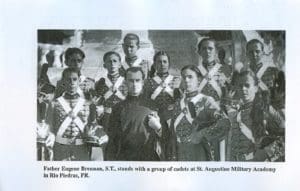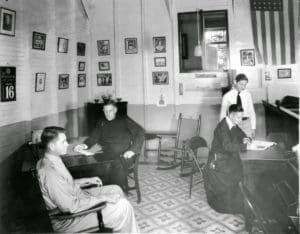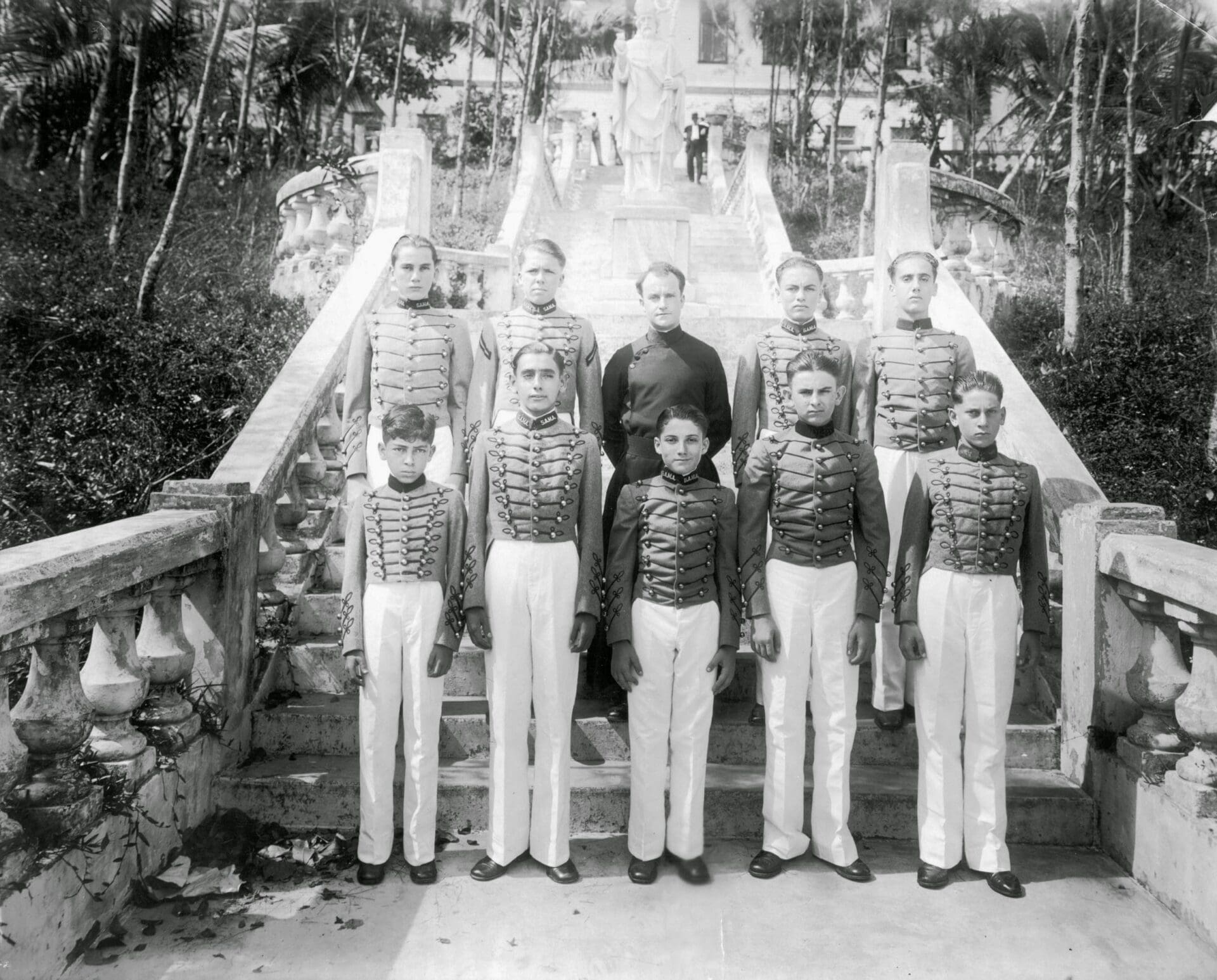By RAYMOND CALIXTE, S.T.
An accredited preparatory school for the young gentlemen of Puerto Rico and Latin America.
INTRODUCTION
Father Thomas Augustine Judge was ahead of his time in 1909 when, in Brooklyn, N.Y., he began his work of making “Every Catholic an Apostle.”
Of Irish descent and a priest of the Congregation of the Mission (Vincentians), Father Judge founded the Missionary Servants of the Most Holy Trinity, a men’s religious congregation, in 1924, in Holy Trinity, Alabama.
Before that, he had founded a women’s religious congregation, the Missionary Servants of the Most Blessed Trinity. Assigning five of these Sisters to Puerto Rico to staff the “Pensionado Católico,” a residence for young women attending the University of Puerto Rico, was the occasion of Father Judge’s first visit to the island, in 1923. This was in response to an invitation from Bishop George J. Caruana, a friend and admirer of Judge, who founded the residence.
Shortly after their arrival in Puerto Rico, the Sisters began attracting native vocations and established a novitiate in Aguadilla. Currently, 98 years after their arrival in Puerto Rico, the Missionary Servants of the Most Blessed Trinity, carry on their ministry in Ponce and El Comandante. They founded and still administer the famous Orientation and Services Center (COS) in Ponce Beach and the Sor Isolina Ferré Center, named for the Sister who served for many years on her native island.
HISTORY OF SAINT AUGUSTINE’S MILITARY ACADEMY
 Saint Augustine’s Military Academy, once known as the West Point of the West Indies and now known as Colegio San José, is located in the foothills of the northern range of Puerto Rico’s mountains, still in the metropolitan area of Río Piedras and San Juan. It is built upon the spot where Bishop William Jones established the academy in 1920. The school was founded to provide education for the poor children of the neighborhood and to promote vocations to the priesthood and religious life. The bishop died without seeing his dream become a reality, and the school became one of the more exclusive and expensive schools in Puerto Rico.
Saint Augustine’s Military Academy, once known as the West Point of the West Indies and now known as Colegio San José, is located in the foothills of the northern range of Puerto Rico’s mountains, still in the metropolitan area of Río Piedras and San Juan. It is built upon the spot where Bishop William Jones established the academy in 1920. The school was founded to provide education for the poor children of the neighborhood and to promote vocations to the priesthood and religious life. The bishop died without seeing his dream become a reality, and the school became one of the more exclusive and expensive schools in Puerto Rico.
Under the direction of the Capuchin priest, Padre Antonio, and the principal, George Keelan, the school officially opened on 6 September 1920 as Saint Augustin’s Military Academy (SAMA).
Those early years did not go well. Bishop George Caruana, who succeeded Bishop Jones, even contemplated selling the property to a USA corporation to build a hotel on the site. He decided, however, to give it another chance, and in 1924 he invited Fr. Judge’s men’s congregation to take over the administration of Saint Augustine’s. Fr. Judge presided over this “second opening” of St. Augustine’s Military Academy in Rio Piedras, Puerto Rico on the feast of the Exaltation of the Cross, September 14, 1926. That was the day when the academy’s administration passed from the Capuchin Franciscans to the Missionary Servants of the Most Holy Trinity.
 The Missionary Servant in charge of the Academy was Father Eugene Brennan, the first Missionary Servant ordained a priest. Father Eugene had been in the U.S. Army before entering the seminary. He obtained accreditation from the Department of Education, and from the United States Department of War he received the permits, rifles and uniforms to facilitate military discipline and accreditation. At the end of four successful years at the Academy, a graduate who so wished was commissioned a Second Lieutenant in the U.S. Army.
The Missionary Servant in charge of the Academy was Father Eugene Brennan, the first Missionary Servant ordained a priest. Father Eugene had been in the U.S. Army before entering the seminary. He obtained accreditation from the Department of Education, and from the United States Department of War he received the permits, rifles and uniforms to facilitate military discipline and accreditation. At the end of four successful years at the Academy, a graduate who so wished was commissioned a Second Lieutenant in the U.S. Army.
The cadets participated in many social and cultural activities. They were honor guards and escorts at annual carnivals and balls. But mostly the Colegio Saint Augustine Military Academy was a center for higher education.
The disastrous hurricane Saint Cyprian of September 26, 1932, followed by some difficult financial years, prompted the withdrawal of the Missionary Servants in 1938.
Bishop Edward Byrne (Bishop of San Juan 1929-1943) then invited the Society of Mary (Marists), under the direction of Father Joseph A. Tetzlaff, SM and Brother Adolf Eiben, SM, to take over responsibility for the Colegio. The Archdiocese of San Juan absorbed the academy’s debt and changed its name to Colegio San José. The Marists sent eight religious to begin the faculty of the Colegio, which had at that time 40 students, 30 of them were interned.
The Congregation of the Marianists continued for two years with the Military Academy, but it was not exactly their charism. Thus, the military orientation of the school disappeared, and they turned the Saint Augustine’s Military Academy into Colegio San Jose continuing as such to the present.
THE GOALS OF THE MISSIONARY SERVANTS FOR THE ACADEMY
Saint Augustine’s Military Academy was established to meet a long-felt need of parents of growing boys in Puerto Rico and in nearby Latin American countries, a need for a school of private and exclusive character where their sons would be guided toward manhood amidst wholesome surroundings, under intelligent discipline and with educational advantages second to none. There was the need to keep the boy as much as possible within parental influence. Year after year many boys left the Island to attend schools in distant places, severing home ties, just at that particular time in their lives when the guidance of their parents is most essential.
Saint Augustine’s Military Academy was fully imbued with the Catholic idea of education, a process of developing the student’s qualities of the soul, body, and mind – including the heart and will. The Catholic idea communicates self-control and good character as the essence of education.
Parents choosing a school for their son look carefully into the kind of mental, physical, and moral training the boy will receive: mental that he may acquire a solid foundation in all branches of knowledge and science; physical, that his body may grow and develop with proper nourishment and exercise to a sturdy manhood; moral that he may be molded into a useful member of the society and be known for this gentlemanliness and nobility of character, including the proper understanding of honor, truthfulness, self-respect, and, above all, reverence for his Maker.
It was the Missionary Servants’ aim and the distinctive purpose of Saint Augustine’s Military Academy to train the boy along these lines during the formative years of his life, building his character for leadership and the performance of duty so that he may be a consolation to his family, a joy to his country, and a glory to God.
WHY MILITARY TRAINING?
The military student training employed at Saint Augustine’s offered a distinctive advantage not found in other school systems. The Military system taught the boy at the very outset the necessity of prompt and cheerful obedience to all proper authority. The daily routine of military training was directed to developing in the cadet outstanding character, alertness, promptness, high sense of duty, leadership, and patriotism. The discipline which the cadet received during this time would stand by him all through his life.
CULTURAL STANDARDS
The graduates of Saint Augustine’s Military Academy, under the leadership formation of the Missionary Servants, were expected to eventually take their places as leaders in the professional, religious, political, business and social life of their communities. Accordingly, the cadets were expected to develop the manners, poise, and correct habits of thought and action indispensable to leadership. The highest moral and religious aspirations were emphasized because education without accompanying high character would be a ruinous bargain.
DISCIPLINE
The disciplinary policy of Saint Augustine’s Military Academy, while strict, was based upon an understanding of the boys’ nature. Each cadet was carefully studied by his prefects and professors so that the outstanding traits of his character could be discovered and developed. The priests, Brothers, Sisters and other members of the faculty and staff, in addition to being thoroughly qualified in their professions, were chosen for their love and dedication to the Christian education of youth.
The cadets had to understand that implicit and immediate obedience was important. Any boy whose influence was found to be bad or was discovered to have vicious habits was dismissed. It was understood by parents that the academy retained the right to expel at any time any cadet whose influence was found to be harmful or who showed that he would not conform to the rules and regulations of the Academy. To this end, the supervising prefect of each dormitory got to know well each cadet in his care.
SPECIAL COURSE
A special course was given at the beginning of the year to train the cadets in gentlemanly conduct, table manners, and other cultural expectations of behavior.
STUDY
The Academy was fully accredited by the Bord of Education of Puerto Rico. Small classes, personal attention given to the backwards students, and compulsory study periods were part of educational regimen, and students were expected to keep up with their class work. To keep up with the pace of study, students at time had to sacrifice their otherwise free time.
CHURCH ATTENDANCE
Every student was required to be present at morning prayers, Mass, night prayers, and benediction of the Most Blessed Sacrament.
HEALTH
Before beginning classes at the opening of school in September each student was examined by the Academy physician, and a close watch is kept on the health of each cadet. Records were kept of the students’ weight, height, and general development. A record is made from time to time of weight, height and general development. A registered nurse, one of the Missionary Servants of the Most Blessed Trinity, was in charge of the infirmary and worked under the direction of the Academy physician.
FOOD AND DIET
Since a boy could not study and enter into other student activities unless he was well fed, special care was taken in feeding the young cadets of Saint Augustine’s Military Academy. The menus were prepared under the direction of a trained dietician, who also gave special attention to the quality of the food as it came from the markets.
CONCLUSION
Because Father Judge never lost sight of the charism of St. Vincent DePaul, his heart was always with the poor and abandoned. He used his Congregation’s presence in Puerto Rico as a personal stepping stone to reaching the underprivileged. Working with the teachers and students at El Pensionado Catolico and Academia San Agustin, having them follow him on missionary journeys, he visited the churches and missions, visiting the sick, baptizing, celebrating marriage – and always inscribing this sacramental activity in the records of the nearest parish. His travels – often on foot or on horseback – took him to San Juan, to churches of San José, San Jorge, San Mateo, Santa Teresita, to the towns of Canovanas and Luquillo, all the way to the heights of El Yunque. Father Judge was in his 60s then, but he rejoiced in the exhaustion of these missionary travels.
The chronicles of these apostolic journeys resemble to those of Saint Paul, with the places, times and circumstances changed. To all of this we must add something quite strange: Father Judge did not speak Spanish. But he never tired of preaching, thanks to his translator and traveling companion, Don Agustin Hernandez, professor at the San Agustin Academy.
Father Judge died in 1933 in Washington DC. In 1938, when the Saint Augustine’s Academy was transferred to the Marist Brothers, the Missionary Servants left the island, but the Sisters stayed. The men’s congregation returned to Puerto Rico in 1957 to take charge of the San Blas Parish in Coamo, then the associated parishes in El Comandante. Today, the Missionary Servants of the Most Holy Trinity carry on Fr. Judge’s mission on the Island, working in Humacao, Loiza and Cubuy de Canovanas.

